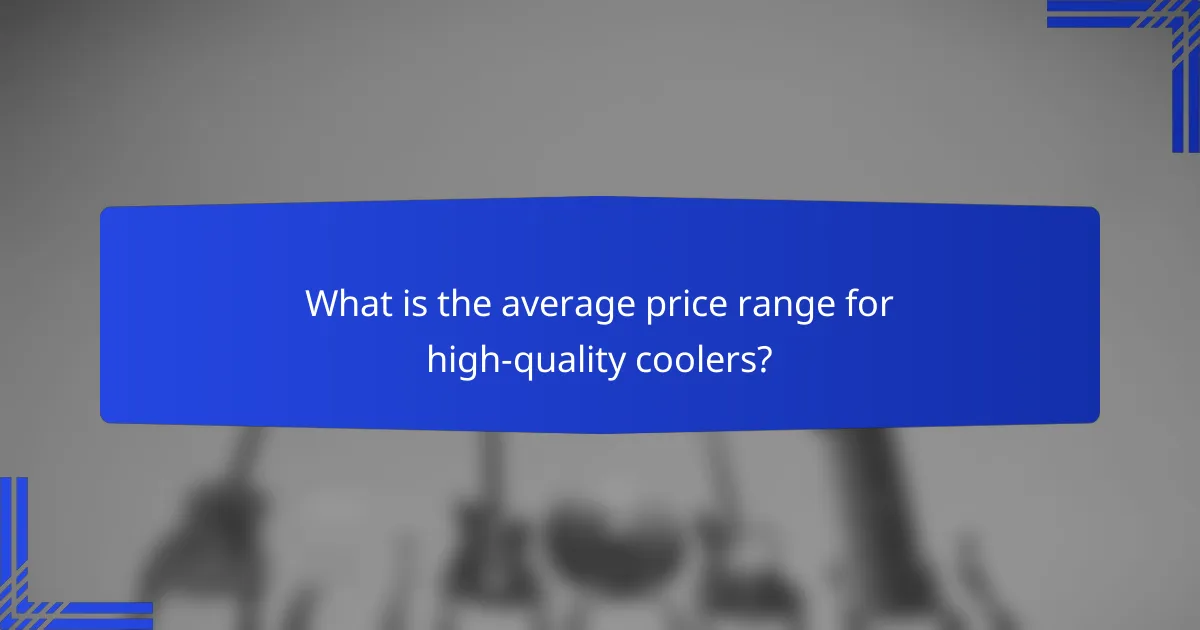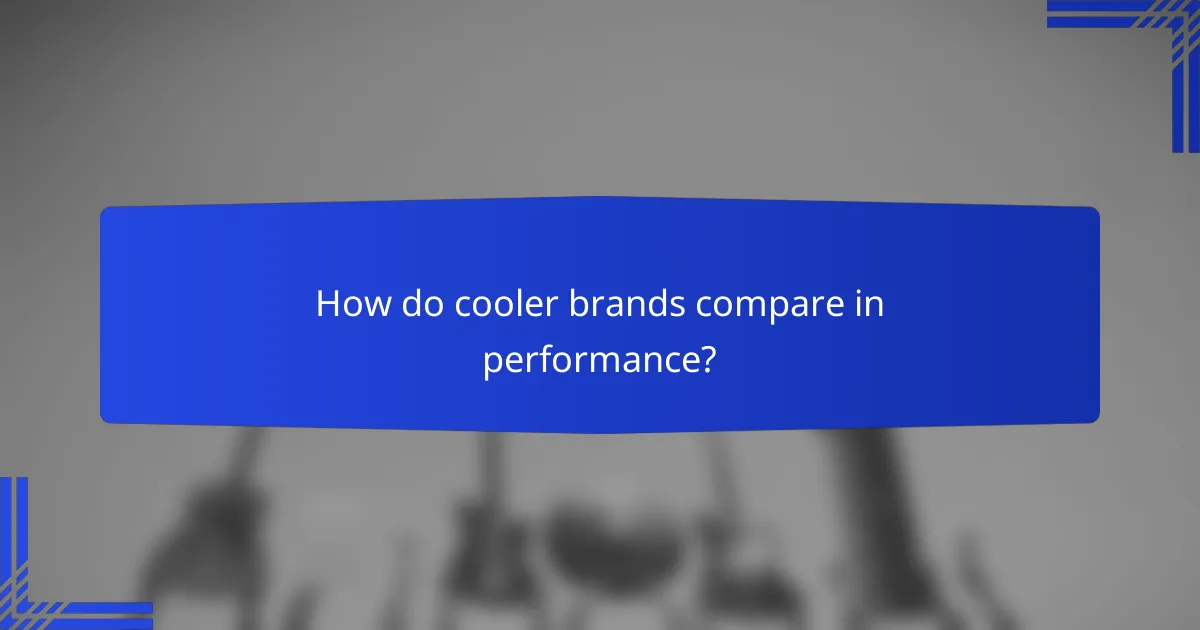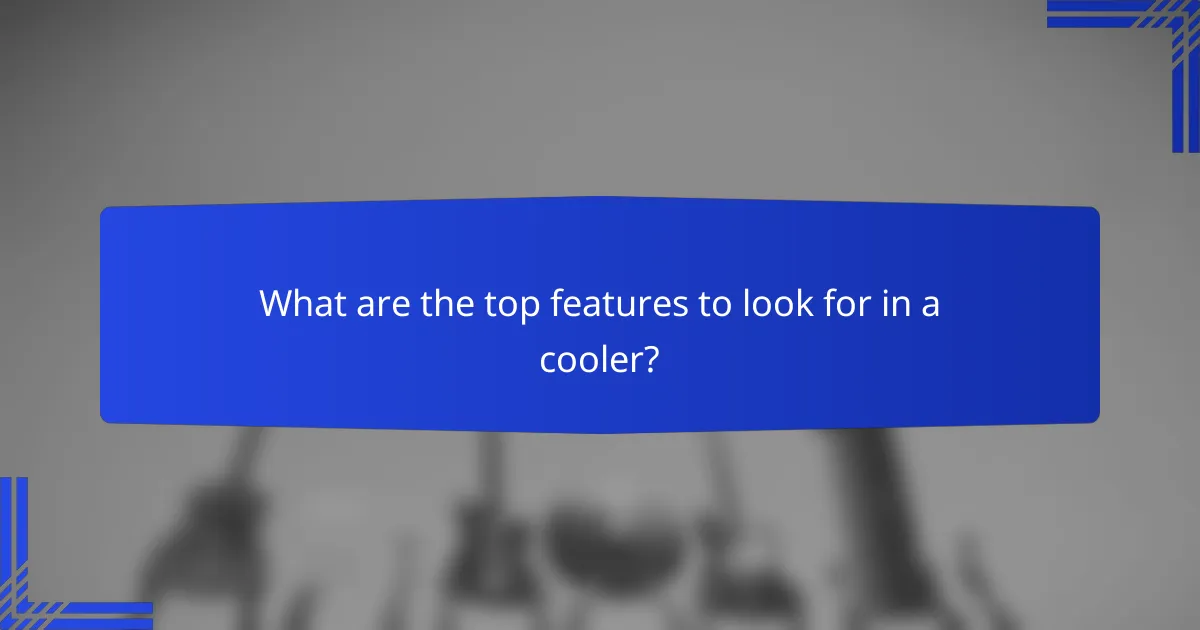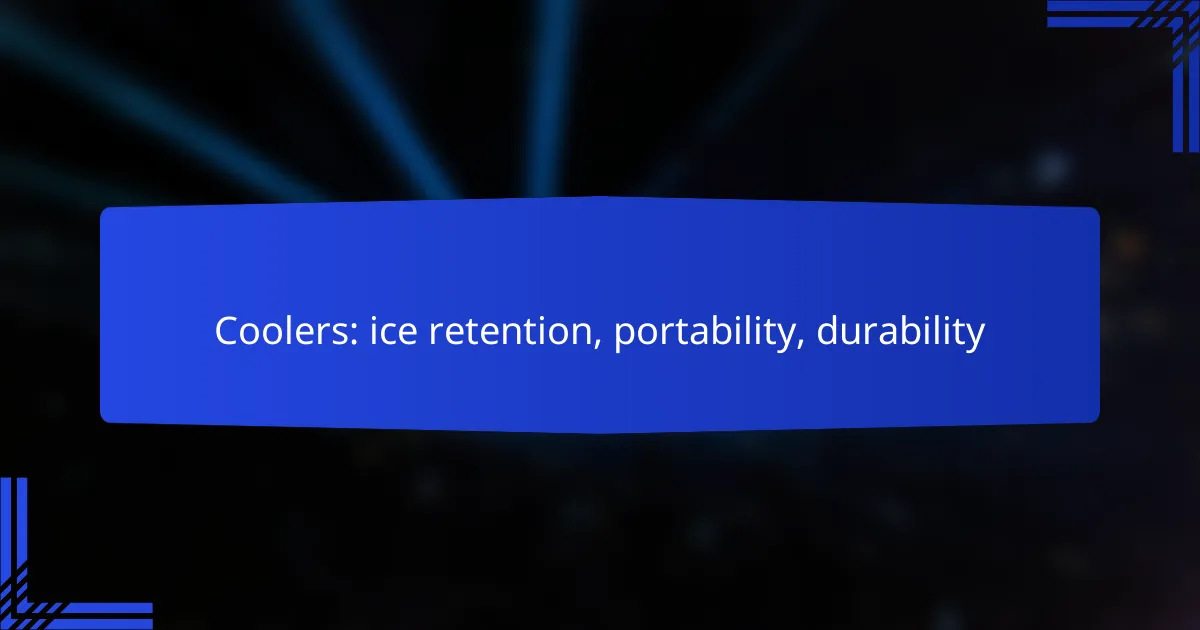Choosing the right cooler involves understanding key features such as ice retention, portability, and durability. High-quality insulation and robust materials ensure that your cooler keeps contents cold for longer, making it perfect for outdoor adventures. Additionally, portability features like weight and design play a crucial role in how easily you can transport your cooler, while durability ensures it can withstand the rigors of outdoor use.

What are the best coolers for ice retention in New Zealand?
The best coolers for ice retention in New Zealand are designed to keep contents cold for extended periods, making them ideal for outdoor activities. Key factors to consider include insulation quality, build materials, and portability features.
YETI Tundra 45
The YETI Tundra 45 is renowned for its exceptional ice retention capabilities, often keeping ice for several days. Its rotomolded construction ensures durability, while the thick insulation minimizes heat transfer.
This cooler is also designed for portability, featuring heavy-duty handles and a lightweight build, making it easy to transport during camping trips or beach outings. However, its premium price point may not suit every budget.
Engel Deep Blue 65
The Engel Deep Blue 65 offers impressive ice retention, often exceeding four days in optimal conditions. Its high-density foam insulation and airtight seal contribute to its efficiency, making it a reliable choice for long excursions.
In addition to its performance, this cooler is built to withstand rugged environments, featuring a robust exterior and stainless steel hardware. While it may be heavier than some alternatives, its durability is a significant advantage.
Igloo Yukon Cold Locker 70
The Igloo Yukon Cold Locker 70 is designed for serious ice retention, often keeping ice for up to five days. Its thick walls and insulated lid help maintain low temperatures, making it suitable for extended trips.
This cooler also includes features like a built-in bottle opener and tie-down points for secure transport. While it is competitively priced, users should consider its bulkiness when planning for portability.

How do portability features affect cooler choice?
Portability features significantly influence cooler selection by determining how easily a cooler can be transported to various locations. Factors such as weight, design, and additional features like wheels can enhance convenience for outdoor activities.
Wheeled designs for easy transport
Wheeled coolers are designed to simplify transportation, especially over longer distances or uneven terrain. They typically feature robust wheels and a sturdy handle, allowing users to pull them with minimal effort.
When choosing a wheeled cooler, consider the wheel size and material, as larger, all-terrain wheels provide better maneuverability on rough surfaces. A cooler with a telescoping handle can also enhance comfort during transport.
Lightweight materials for hiking
For hiking and backpacking, lightweight coolers made from materials like soft-sided fabric or thin, insulated plastics are ideal. These coolers prioritize portability while still offering reasonable ice retention for short trips.
When selecting a lightweight cooler, look for features like adjustable straps or backpack-style designs that allow for hands-free carrying. Keep in mind that while lighter materials may sacrifice some durability, they can significantly reduce the load during long hikes.

What durability factors should be considered?
When evaluating cooler durability, consider factors like construction materials, resistance to environmental elements, and overall build quality. A durable cooler should withstand rough handling, extreme temperatures, and exposure to UV rays without compromising performance.
Rotomolded construction benefits
Rotomolded construction is a manufacturing process that creates a single, seamless piece of plastic, enhancing a cooler’s durability. This method allows for thicker walls, which provide better insulation and impact resistance compared to traditional coolers.
Coolers made with rotomolded construction are often more resistant to cracking and can endure rough outdoor conditions. They are ideal for camping, boating, or any activity where the cooler may be subjected to heavy use.
UV-resistant materials
UV-resistant materials are crucial for coolers that will be exposed to sunlight for extended periods. These materials prevent degradation and fading, ensuring that the cooler maintains its appearance and structural integrity over time.
When selecting a cooler, look for products labeled as UV-resistant, as they will last longer in outdoor settings. This feature is particularly important for those who frequently use their coolers at the beach or on sunny days.

What is the average price range for high-quality coolers?
The average price range for high-quality coolers typically falls between $150 and $400, depending on the brand and features. These coolers are designed for superior ice retention, portability, and durability, making them ideal for outdoor activities.
$150 to $400 for premium brands
Premium coolers in the $150 to $400 range often feature advanced insulation technology and rugged construction. Brands like YETI and Pelican are known for their high performance, ensuring ice retention for several days under various conditions.
When considering a cooler in this price bracket, look for features such as rotomolded construction, heavy-duty latches, and built-in bottle openers. These elements enhance usability and longevity, making them worthwhile investments for serious outdoor enthusiasts.
Budget options under $100
For those seeking budget-friendly coolers, options under $100 are widely available and can still offer decent performance. Brands like Coleman and Igloo provide reliable coolers that are suitable for casual outings, picnics, and short trips.
While these coolers may not retain ice as long as premium models, they often include basic insulation and lightweight designs for easy transport. When selecting a budget cooler, prioritize size and portability to match your specific needs.

How do cooler brands compare in performance?
Cooler brands vary significantly in performance, particularly in ice retention, portability, and durability. Understanding these differences can help you choose the right cooler for your needs, whether for camping, tailgating, or outdoor events.
YETI vs. Coleman ice retention
YETI coolers are known for their superior ice retention capabilities, often keeping ice for several days under optimal conditions. In contrast, Coleman coolers typically offer decent performance but may only retain ice for a day or two, depending on the model and external temperatures.
When choosing between YETI and Coleman, consider your usage scenario. If you plan on extended trips where ice retention is critical, YETI is likely the better choice. For shorter outings, a Coleman cooler may suffice and be more budget-friendly.
Engel vs. Igloo durability
Engel coolers are designed for rugged use, featuring rotomolded construction that withstands harsh conditions and impacts. This makes them ideal for serious outdoor enthusiasts who need a reliable cooler that can endure rough handling.
On the other hand, Igloo coolers are generally made with lighter materials, which can be more portable but may sacrifice some durability. If you prioritize weight and ease of transport, Igloo could be suitable, but for long-term durability, Engel stands out.

What are the top features to look for in a cooler?
The top features to consider in a cooler include insulation thickness, drainage systems, portability, and durability. These elements directly impact the cooler’s ice retention capabilities, ease of use, and overall longevity.
Insulation thickness
Insulation thickness is crucial for maintaining low temperatures and extending ice retention. Generally, coolers with thicker insulation (around 2 to 3 inches) can keep ice for several days, while those with thinner walls may only last a day or two. When selecting a cooler, look for models that specify their insulation material and thickness for optimal performance.
Consider the type of activities you’ll be using the cooler for. For extended camping trips or beach outings, prioritize coolers with superior insulation. Conversely, if you’re only using it for short events, a less insulated option may suffice.
Drainage systems
A good drainage system simplifies cleaning and helps remove melted ice efficiently. Many coolers feature a drain plug located at the bottom, allowing for easy water removal without tipping the cooler. Ensure the drainage system is well-designed to prevent leaks and spills.
When evaluating coolers, check for features like a threaded drain plug for attaching a hose or a built-in channel that directs water away from the cooler. These enhancements can significantly improve usability, especially during outdoor activities where convenience is key.
